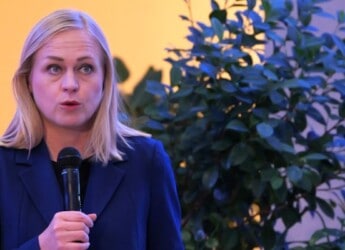Editor’s Note: Vladimir Putin’s latest declarations at the St. Petersburg International Economic Forum strip away any lingering ambiguity about Russia’s strategic intentions in Ukraine. By demanding Ukraine abandon its alliances and cede sovereignty over annexed regions, the Kremlin is not just prolonging war—it’s codifying imperialism. This article offers a critical analysis of the military and geopolitical dynamics shaping the ongoing conflict, from renewed nuclear rhetoric and expanding drone warfare to shifting U.S. diplomatic overtures in Eastern Europe. For cybersecurity, information governance, and eDiscovery professionals, understanding these evolving risks—especially in terms of infrastructure targeting, disinformation campaigns, and strategic technological escalations—is essential for anticipating threat vectors in a persistently unstable geopolitical environment.
For those seeking to grasp the full scope of this evolving landscape, the complete updates from the Institute for the Study of War serve as an invaluable resource.
Content Assessment: Putin Redoubles Demands: New Peace Terms Cement Russia’s Expansionist Agenda
Information - 94%
Insight - 93%
Relevance - 92%
Objectivity - 95%
Authority - 96%
94%
Excellent
A short percentage-based assessment of the qualitative benefit expressed as a percentage of positive reception of the recent article from ComplexDiscovery OÜ titled, "Putin Redoubles Demands: New Peace Terms Cement Russia’s Expansionist Agenda."
Background Note: ComplexDiscovery’s staff offers distinctive perspectives on the Russo-Ukrainian war and Middle Eastern conflicts, informed by their military experience on the West German, East German, and Czechoslovakian borders during the Cold War, as well as in Sinai as part of Camp David Accord compliance activities, during the timeframe of the Persian Gulf War. This firsthand regional knowledge has been further enhanced by recent staff travels to Eastern European countries, including Estonia, Finland, Latvia, Lithuania, and Poland. These visits have provided up-to-date, on-the-ground insights into the current geopolitical climate in regions directly impacted by the ongoing conflict.
Combined with cybersecurity, information governance, and eDiscovery proficiency, this multifaceted experience enables comprehensive analysis of these conflicts, including the critical impact of cyber warfare, disinformation, and digital forensics on modern military engagements. This unique background positions ComplexDiscovery to provide valuable insights for conflict-related investigations and litigation, where understanding the interplay of technology, data, and geopolitical factors is crucial.
Russo-Ukrainian Conflict Update*
Putin Redoubles Demands: New Peace Terms Cement Russia’s Expansionist Agenda
ComplexDiscovery Staff
Putin’s Ultimatum: Conditions for Capitulation
Russian President Vladimir Putin has reaffirmed his rigid preconditions for peace, revealing unwavering ambitions for Ukrainian subjugation and territorial revisionism. In a high-profile interview on June 20, Putin declared that Kyiv must renounce alliances, commit to nuclear non-proliferation, and recognize Russia’s control over the illegally annexed territories—Donetsk, Luhansk, Kherson, and Zaporizhia—or face perpetual hostility. This public reaffirmation at the St. Petersburg International Economic Forum leaves little ambiguity about the Kremlin’s intentions: to severely curtail Ukrainian sovereignty and agency, subordinating Kyiv’s future to Russian strategic interests.
Kyiv’s Rebuttal and Renewed Western Appeals
Ukrainian President Volodymyr Zelensky responded forcefully, interpreting Putin’s statements as confirmation of imperial ambitions that could extend beyond Ukraine to other post-Soviet states. Foreign Minister Andriy Sybiha emphasized the destructive trail left by Russian forces and called for intensified Western measures, including military support and diplomatic isolation of Moscow.
Escalation Tactics: Nuclear Rhetoric and Disinformation
Simultaneously, the Kremlin has revived disinformation campaigns, specifically the allegation that Ukraine is preparing to deploy a “dirty bomb.” These claims, echoed by Security Council Deputy Chair Dmitry Medvedev who threatened nuclear retaliation, aim to undermine Western resolve and stoke anxiety over escalation. This rhetorical maneuver mirrors earlier nuclear brinkmanship from 2022, deployed to blunt international military aid flows to Ukraine.
Battlefield Update: Limited Gains, Mounting Costs
On the ground, the tactical situation across the frontlines remains complex but marked by incremental Russian advances in specific sectors. Russian forces recently secured gains near Novopavlivka and Velyka Novosilka, with geolocated footage confirming territorial acquisitions in Shevchenko and eastern Zaporizhia. Elements of the 36th Motorized Rifle Brigade were reportedly instrumental in capturing the latter, suggesting the Eastern Military District’s growing involvement in offensive maneuvers.
Elsewhere, significant Russian efforts in the Kharkiv and Sumy directions have failed to yield advances despite heavy troop concentrations. President Zelensky stated that over 52,000 Russian personnel are engaged in the Sumy axis alone, accounting for nearly a quarter of all strikes along the front. Russian troops attacked areas such as Yablunivka and Yunakivka, while Ukrainian forces reportedly counterattacked around Andriivka.
In the east, Russian attempts to capture remaining portions of Luhansk and advance toward Donetsk Oblast have been similarly stymied. Attacks near Kupyansk, Borova, and Lyman did not produce confirmed advances. Notably, Russian operations in the Lyman direction now reportedly incorporate drone support in up to 80% of assaults, although the troops remain undertrained despite numerical superiority.
The Donetsk axis, a long-standing focal point for Russian operations, witnessed continued assaults toward Chasiv Yar and Toretsk without meaningful progress. Nevertheless, reports indicate a Russian push to cut off Ukrainian supply lines west of Chasiv Yar and to bypass Toretsk altogether, albeit amid logistical challenges and reported supply deficits on the Russian side.
Drone Warfare and Strategic Adaptation
A notable development in Russian military innovation is the dramatic scaling of drone warfare. Ukrainian EW expert Serhiy Beskrestnov estimated that Russia has increased Shahed drone production sevenfold, with plans for massive strike packages comprising up to 800 drones—more than double their typical scale. Modernized Geran-2 drones are being equipped with upgraded engines, warheads, and electronics, enabling them to strike five to seven kilometers from frontlines. This evolution reflects a strategic pivot toward cost-effective and adaptive long-range strike tactics, with growing domestic production capacity mitigating dependence on Iranian imports.
Diplomatic and Geopolitical Undercurrents
In the broader geopolitical theater, the United States made an unexpected diplomatic overture to Belarus. Special Envoy General Keith Kellogg’s visit to Minsk marks the first high-level U.S.-Belarus engagement since 2020 and included the release of 14 political prisoners. Though limited in scope, the visit may signal a recalibration of U.S. engagement policy in Eastern Europe amid the prolonged conflict.
Meanwhile, Russia has renewed efforts to adjust its territorial waters in the Baltic Sea. The June 20 proposal reintroduces elements of a previously retracted 2024 initiative, aiming to redefine maritime borders in the Gulf of Finland. While the new plan omits Kaliningrad-related changes, its timing and content suggest continued Russian efforts to challenge NATO-aligned Baltic states’ security architecture through legal and cartographic maneuvers.
Sustained Pressure and the Question of Western Resolve
In southern Ukraine, the situation around Zaporizhzhia remains static, though Russian forces carried out limited assaults around Hulyaipole and Kamyanske. Further west, strikes near the Antonivsky Bridge east of Kherson failed to alter frontline positions. Russian aerial operations, however, intensified. Between June 20 and 21, Ukrainian air defenses intercepted significant portions of a large-scale strike package that included ballistic and cruise missiles alongside nearly 300 drones. Civilian and energy infrastructure in Kharkiv and Poltava Oblasts bore the brunt of these attacks, underlining the enduring Russian intent to cripple Ukrainian rear-area resilience.
The enduring tempo of operations and the technological evolution of Russia’s drone fleet underscore a broader strategic reality: despite static frontlines in many sectors, the war continues to evolve in lethality and sophistication. This evolution, combined with Putin’s reaffirmed maximalist objectives, poses a profound challenge for Ukrainian defenders and their international partners.
What remains uncertain is whether Western political will—fractured by domestic pressures and geopolitical fatigue—can endure long enough to counter Russia’s attritional approach and uphold the defense of Ukraine’s sovereignty.
Detailed Reporting with Maps for June 21, 2025, from the ISW – Mouseover to Scroll
Russo-Ukrainian War June 21 2025 - UpdateReview the Detailed Reporting and Maps PDF
About the Institute for the Study of War Research Methodology
ISW’s research methodology relies on both primary and secondary sources, enabling researchers to develop a comprehensive understanding of the situation on the ground. In order to analyze military and political developments in any given area, ISW’s research analysts must wholly understand the systems of enemy and friendly forces. They must also understand the population demographics, physical terrain, politics, and history of that area. This lays the analytical foundation for understanding the reasons for particular developments and fulfilling their assigned research objectives. ISW analysts also spend time in places like Iraq, Afghanistan, and elsewhere in order to gain a better understanding of the security and political situation and to evaluate the implementation of current strategies and policies. Their researchers compile data and analyze trends, producing a granular analysis of developments in areas of research, producing an accurate, high-resolution, timely, and thorough picture of the situation. ISW’s research methodology guarantees its success and commitment to improving the nation’s ability to execute military operations, achieve strategic objectives, and respond to emerging problems that may require the use of American military power.
About the Institute for the Study of War
The Institute for the Study of War advances an informed understanding of military affairs through reliable research, trusted analysis, and innovative education. They are committed to improving the nation’s ability to execute military operations and respond to emerging threats in order to achieve U.S. strategic objectives. ISW is a non-partisan, non-profit, public policy research organization.
Learn more, get involved, and contribute today.
Assisted by GAI and LLM Technologies
* Sourced and shared with direct expressed permission from the Institute for the Study of War (ISW).
Additional Reading
- From Dissent to OSINT? Understanding, Influencing, and Protecting Roles, Reputation, and Revenue
- Data Embassies: Sovereignty, Security, and Continuity for Nation-States
Source: ComplexDiscovery OÜ



























